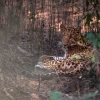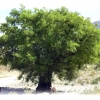The cool winter morning was an ideal day to be outdoors and in the field. The five of us were strolling down in the heat as we walked across the mixed forest of Manas National Park (MNP) looking for signs of tigers near the breathtaking Manas river, adjacent to the famous Mathunguri guest house of Manas. This was 2015, and we were in the area as a part of a survey to monitor tigers, co-predators and prey, and to determine the factors affecting their presence.
With an area of 500 sq km, MNP is located in the Baksa and Chirang districts of Bodoland Territorial Council in the state of Assam. The boundary of MNP is clearly distinguished, to the north by the Manas River demarcating the international border shared with the Royal Manas National Park (RMNP) in Bhutan, to the south by thickly populated villages, and to the east and west by the forest reserves. MNP forms the core area of the larger Manas Tiger Reserve which extends between the river Sankosh in the west to the river Dhansiri in the east.
This unique landscape of around 1,500 sq km represents immense diversity, ranging from tropical grasslands at 40 to 150 m, through subtropical forest at 300 m, to warm broad-leaved forest above 1,000 m reaching up to 2,000 m. The combined complex is characterized by its rich and unique biodiversity as well as its spectacular scenic attributes created by the meandering river, forested hills, alluvial grasslands and tropical evergreen forests. MNP lies on a gentle alluvial slope in the foothills of the Himalayas, where wooded hills give way to grasslands and tropical forest. It is home to a great variety of wildlife, including many endangered species such as the tiger (Panthera tigris), the pygmy hog (Porcula salvania) and the Asian elephant (Elephas maximus). The park provides habitat for 22 of India’s most threatened species of mammals listed in Schedule I of the Wildlife (Protection) Act, 1972, besides several other endangered species.
Carrying out the survey has become a routine activity for our team in Manas for the past few years, along with our partner organizations, namely Aaranyak and ATREE. Between 2010 and 2015 we were able to collect sufficient data to assess the potential of Manas as a site where the tiger population can be revived further from its current status. We already had certain assumptions about the distribution of tigers and factors that affect their movement. Therefore, while collecting signs of tigers we also took note of human disturbance and the prey base during our study. These indicators help us to analyze factors which affect tiger movements in any space.
We were a team of five people—two colleagues, two field assistants and me. The plan usually involved spending nights in forest camps and after completing the survey of that area to move on to the next camp. We had to carry basic supplies including rice, dal, tea and some utensils. Much of our expedition involved searching along nallahs (watercourses) and patrolling roads, both during the morning and noon session, walking an average of 10 km on a daily basis and at the end of these long days, enjoying moonlit nights at forest camps.
While on the one hand I loved our morning and noon walks, getting excited as soon as signs of hidden life started appearing, on the other hand, at the end of a few explorations my muscles would be so stressed that even boarding the vehicle sent to pick us up was a terror. Sometimes the terrains were so difficult that even establishing foot trails became a horrendous task. This was not the only challenge or difficulty that we faced. We had to find the best possible locations for putting up camera traps for photo-capturing tigers and other wildlife. These camera traps needed to be placed strategically so that the area was well covered with cameras and it had the maximum chances of photo-capturing the animals. Camera trapping is known to be a quantitative technique that has comparatively low labour costs, is non-invasive, incurs minimal environmental disturbance, is robust to variation in ground conditions and climate and, above all, can be used to gain information on highly cryptic species and in difficult terrain where other field methods are likely to fail. Furthermore, camera traps are equally efficient at collecting data by day and night and provide the opportunity to collect additional information on species distribution and habitat use, population structure and behaviour.
In each forest camp, I always spared time to walk around before going for the survey. I often got mesmerized with the surrounding beauty and even with just the pleasure of walking in such a serene environment. I have to agree with Henry David Thoreau when he writes, 'Methinks that the moment my legs begin to move, my thoughts begin to flow...' One day I saw a black-winged kite in mid-air as it searched the ground below for its prey near the Kuribeel camp where we had come for a tea break. Mynahs and robins were ubiquitous. Rose-ringed parakeets remained at the edge of the road, seemingly indifferent to my tampering with the binocular and camera.
After a few more days of deploying camera traps in various locations, we came to an area called Mathanguri near the Bhutan border late at night. A trip to Manas is incomplete without a visit to this mesmerizing locale. The next morning the forest came to life with chirping birds and soon the sun filled the surroundings with its brilliant light! That day the walk took us across the Manas River. We crossed the river in a raft which reminded me of the whitewater rafting that we did many years back during our college days. It was one of the toughest stretches so far and it took a lot of effort for us to reach the actual forest patch where we wanted to put the camera traps. But long before we even entered this patch we sighted wild dogs and wild buffaloes, which was a true bonus and took our breath away.
Nature is a mystery and many of its mysteries still remain unsolved. A few forest patches in Manas have no deficiency in terms of prey base, water source, forest density and lack of human disturbance. These patches would seem to be ideal habitats for tigers, but to our surprise we did not find even a single sign of tigers or even leopards. I sometimes wonder if we humans think that we know almost all the facts of nature, but that in fact is not true! Topics like these often became a part of our discussions back at our camp site, while enjoying the silence of the forest. We engrossed ourselves in the delicious meal that was sometimes served on banana leaves that seemed as local as the forest itself.
There is a road running along the Bhutan border known as Doimara road that has often been reported as an area of good wildlife movement due to its proximity to the RMNP in Bhutan, which is relatively dense forest. When we reached this road, we were overawed by the spectacular view before us. The track to the road was beautiful and pleasing beyond all expectation. A plethora of greens and browns surrounded us and continuous sounds made by who-knows-what creature kept us all guessing. Just as, after a turn in the path, sunlight emerged through the dense canopy and touched the carpet of fallen leaves over which we were walking, a vocal colourful flock of jungle fowl made a surprise appearance in the early morning light and offered us a fleeting but most graceful vision.
Our survey took over two months and we were astonished when we collated all the data. We photo-captured all the major carnivores and herbivores from MNP during the survey. A total of three families representing seven genera comprising nine species of carnivores were photo-captured. Beside the tiger and leopard (Panthera pardusi), which have been photographed before, we were able to get images of the rare clouded leopard (Neofelis nebulosa), leopard cat (Prionailurus bengalensis), jungle cat (Felis chaus), dhole (Cuon alpinus) and sloth bear (Melursus ursinus), as well as the first picture documentation of other major carnivores, which included the black panther (melanistic leopard) and the Himalayan black bear (Ursus thibetanus) from MNP. Apparently the camera trap picture of the Himalayan black bear during the survey was potentially noteworthy as this was the first time that it was recorded in MNP; in earlier records the Himalayan black bear was reported only on the Bhutan side of Manas.
Out of the nine species photo captured, two (tiger and dhole) are classified as Endangered, three (clouded leopard, Himalayan black bear and sloth bear) are classified as Vulnerable, while the leopard is classified as Near Threatened, as per the International Union for Conservation of Nature’s red list data. We think some regional ecological settings could be playing a role in the assemblage of such diverse carnivores in MNP, which necessitates further research.
The forests of the Manas have been threatened by insurgency problems and illegal logging since the early 1990s. In the last 10-15 years approximately one-third to half of the three Reserve Forests within the tiger reserve, viz., Ripu, Chirang, and Manas, has been deforested. The MNP as a whole remains intact, although the buffer zone has suffered many encroachments, especially between the Sankosh River in the far west and the Manas river, which has led to the fragmentation of the forest. About 15 sq km in the Panbari Reserve Forests (the western core zone of the Park) have been illegally occupied since 1973. There is no buffer to the south, and village communities on the edge collect resources like grasses, fuel, wood, fodder, timber, and graze their livestock in the Park. Villagers believe that these uses are theirs by right, which have been denied to them since the designation of the Tiger Reserve in 1973.
These Reserve Forests and the RMNP of Bhutan that borders the north are potential habitats for large umbrella species like the tiger in India and Bhutan. However, with recent positive efforts from government agencies including the Forest Department and involvement of various NGOs and local communities, wildlife populations, including carnivores, which were affected as a consequence of the ethnic agitation, are recovering well. Recently, there have also been some developments around an emerging system and agreement on a trans-boundary joint protection and management regime, which would be implemented with Bhutan. Since the forests of Bhutan contiguous to Manas provide critical corridors for the movement of large animals and act as a safe refuge for them during disturbance and conflicts in the Indian part owing to higher population and developmental pressures, coming to an understanding on a joint transboundary system is significant.
As I write this article, the thought comes to me that all that once dominated our forest—the birds, trees and animals—are becoming rare and are being gradually replaced by signs of development like roads, railways and all kinds of linear infrastructure cutting across the pristine forest patches in many places. It seems that MNP is standing at a crossroads today. While on the one hand it holds out the prospect of long-term landscape conservation in some kind of collaboration with a human population whose density is high and increasing, on the other hand, it faces the risk of being islanded, surrounded by concrete jungles devoid of any wildlife. As for me, the survey was definitely a date with the wild, which I will remember all my life and which will inspire me to engage in similar endeavors, pushing me to contribute to the cause of conserving our nature and saving the best for posterity.












